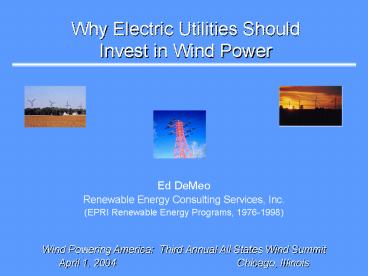Wind Energy Cost Trend - PowerPoint PPT Presentation
1 / 16
Title:
Wind Energy Cost Trend
Description:
Cost has been defined in conventional, narrow terms ... gas synergy: save gas when wind blows; burn gas to provide system reliability during low winds ... – PowerPoint PPT presentation
Number of Views:61
Avg rating:3.0/5.0
Title: Wind Energy Cost Trend
1
Why Electric Utilities Should Invest in Wind Power
Ed DeMeo Renewable Energy Consulting Services,
Inc. (EPRI Renewable Energy Programs, 1976-1998)
Wind Powering America Third Annual All States
Wind Summit April 1, 2004
Chicago, IIlinois
2
Why? Major Reasons
- Costs of electrical energy
- Operational synergy with natural gas
- Environmental stewardship
- Customer preferences
- Public policy directives
3
Electric Utility Sector Historical Responsibility
Reliable Power Lowest Cost Environmental Quality
Conventional Business Drivers
Traditional Charter
- Traditionally, the utilities job has been to
provide reliable power on demand at the lowest
cost - Cost has been defined in conventional, narrow
terms - Environmental acceptance has been a
consideration, but cost and reliability have
taken precedence
4
Electric Utility Sector New Directions
- Traditionally, the utilities job has not been to
pursue new technologies and approaches - There has been little, if any, reward for taking
risks
Environmental Quality Fuel Diversity Energy
Security Local Economic Development Public
Preferences
New Directions
Policy Drivers
- Movement in new directions with new risks
requires direction from the public-policy sector - Public preferences can make good business sense
with well-designed policy incentives
5
Electric Utility Sector Business Evolution
Reliable Power Lowest Cost
Conventional Business Drivers
Traditional Charter
Environmental Quality Fuel Diversity Energy
Security Local Economic Development Public
Preferences
New Directions
Policy Drivers
The combination of policy directives and business
drivers broadens the electric-power charter to
encompass reliable power at lowest all-inclusive
societal cost over the long term
6
Wind Energy Cost Trend
1979 40 cents/kWh
2000 4 - 6 cents/kWh (no subsidy)
- Increased Turbine Size
- RD Advances
- Manufacturing Improvements
- Operating Experience
NSP 107 MW Lake Benton wind farm 4 cents/kWh
(unsubsidized)
2004 3 - 5 cents/kWh (no subsidy)
7
Natural Gas Situation
- Todays tight natural gas markets have been a
long time in coming, and distant futures prices
suggest that we are not apt to return to earlier
periods of relative abundance and low prices
anytime soon - Alan Greenspan, Federal Reserve Chairman,
Testimony at Senate hearing, July 10, 2003
Wellhead gas costs - 2002-2003 3 - 5/MMBTU
8
Cost Comparison
- Wind total capital cost 1,000 - 1,100 kW today
- Wind energy cost about 3/kWh (4 without PTC)
- Includes 0.5 to 1.0/kWh for OM
- Wind energy costs are stable over plant lifetime
Natural-gas plant fuel cost (HR 7,000 - 10,000)
/MMBTU 2 4 5 6 8 gas
cost /kWh 1.4 - 2 2.8 - 4 3.5 -
5 4.2 - 6 5.6 - 8 fuel only
- Wind-gas synergy save gas when wind blows burn
gas to provide system reliability during low winds
9
Environmental Benefits
- No emissions of any kind during operation
- No SOx, NOx, particulates or mercury
- No contributions to regional haze
- Hedge against environmental regulations
- No greenhouse gases
- Global climate change is a serious concern to
every major political entity worldwide except the
current Administration in Washington, DC - Avoidance not politically sustainable in the U.S.
or worldwide - No toxic wastes or health impacts
- Nuclear waste transport and storage unresolved
- Respiratory diseases of growing concern
10
What Does Energy Really Cost?
- Nuclear power
- Federal government underwrites accident liability
- Waste-handling costs significant and unknown
- Coal power
- Respiratory concerns becoming prominent
- 350 M/yr to coal miners with black lung disease
- Numerous health-costs estimates 2 - 4/kWh
(highly uncertain but not zero) - Oil and gas
- Depletion allowances
- DOD expenses to maintain supply channels
These costs are paid in tax and health bills --
not electricity bills. The federal Production
Tax Credit (PTC) for wind compensates to a degree
11
Citizens Views on Wind Energy and Utility
Responses
- Ask customers how they feel about renewables
- Solid positive response across the nation
- Can offer green-priced product in response
- Green pricing helped get the ball rolling, but it
may be an idea whose time has come and gone
Strong positive response from the customer base
justifies addition and ratebasing of wind
power Almost everyone is willing to pay a small
premium -- and they may not need to!
12
Nebraska Public Power District Deliberative
Polling Customer Meeting on Energy Alternatives
- NPPD Customer Meeting on Energy Alternatives held
August 9, 2003 in Grand Island, NE - 109 participants from 80 Nebraska communities
served at Retail or by Wholesale Distributors. - Great discussion on Energy Generation
Alternatives including coal, natural gas, wind,
methane and solar.
13
(No Transcript)
14
(No Transcript)
15
State Renewable Portfolio Standards (RPS)
ME 30 by 2000
MN 3.6 by 2002 and 5 by 2012
WI 2.2 by 2011
MA 11 by 2009
NY 25 by 2012
CT 13 by 2009
NV 15 by 2013
NJ 6.5 by 2012
PA varies by utility
CA 20 by 2017
IA 2 by 1999
- 14 state standards
- Technology, vintage, credit trading, sunset,
location eligibility requirements differ
AZ 1.1 by 2007, 60 solar
NM 5 of standard offer
TX 2.2 by 2009
Source AWEA
16
Electric Utility Sector Business Evolution
Reliable Power Lowest Cost
Conventional Business Drivers
Traditional Charter
Environmental Quality Fuel Diversity Energy
Security Local Economic Development Public
Preferences
Policy Drivers
New Directions
The combination of policy directives and business
drivers broadens the electric-power charter to
encompass reliable power at lowest all-inclusive
societal cost over the long term































